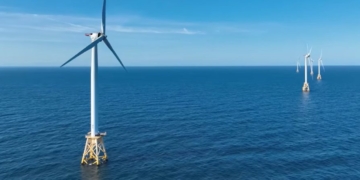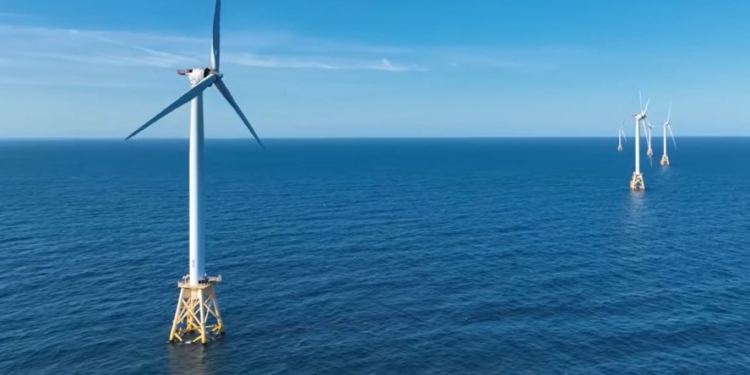Little noted amid the media reporting about the collapse of a gigantic wind blade at the Vineyard Wind 1 project off the coast of Massachusetts last week is the fact that the blade in question was a replacement made necessary when another blade was damaged during the installation process.
That first blade was successfully removed without creating a disastrous pollution incident, a fact that cannot be said about its replacement.
That replacement blade’s collapse littered the Atlantic Ocean with dangerous fragments of blade fillings containing shards of fiberglass. Not only did the fragments force the closing of beaches on Nantucket Island and the forced shut-down of Vineyard Wind’s operations, but many observers are concerned the shards of fiberglass now present a danger to whales, dolphins and other marine mammals, some of which are listed under the Endangered Species Act.
New England Fishermen’s Stewardship Association CEO Jerry Leeman told the Cape Cod Times that “shards of fiberglass, which are not biodegradable, are a huge threat to whales, dolphins and porpoises, some of which are endangered. Nanoparticles from the fiberglass could even enter the food web if zooplankton mistake particles for forage. This slow-rolling disaster is a serious threat to fishery sustainability.”
Amy DiSibio of ACK for Whales echoed Leeman’s concerns, saying: “There are lots of pieces still on the beach. I mean, they cannot pick all of this stuff up. What I’m more worried about, is the long-term effect here on fish, and on the food chain here… what, are we all going to be eating this stuff?”
One reason the cleanup crews have found their jobs difficult and ongoing for days is the sheer volume of insulation contained in the gigantic Vineyard Wind blades. Perched atop towers almost as tall as the Eiffel Tower, these blades are 107 meters in length, roughly the length of a standard soccer pitch. When viewed from a distance, which is all that most citizens experience, it is difficult to imagine the size of these things. Up close, the sheer scale of them is almost shocking to behold.
For their own part, spokespersons for Vineyard Wind 1 have worked hard to shift blame for this environmental disaster to the manufacturer, GE Vernova. The company released an initial environmental analysis this week claiming that the blade’s materials are “inert, non-soluble, stable, and nontoxic” materials, similar to those found in “textiles, boat construction and the aviation industry.” The report further notes that the materials are “considered non-hazardous and classified for landfill disposal, when retired.”
The report does not address concerns by Nantucket residents about the potential for swimmers to be cut by shards of fiberglass, nor does it address Leeman’s and DiSibio’s worries about possible harm to marine life. This only adds to the region’s previous concerns over the dramatic rise in beachings of whales and other marine mammals that have corresponded to the startup of development for the massive industrial wind projects.
The blade that caused all this damage and alarm is just one of thousands the Biden-Harris regime hopes to subsidize into existence in the Northeast Atlantic alone. That is in addition to similar goals for the central part of the Gulf of Mexico, where these behemoths would be sited in the midst of what the government itself has referred to as a “super highway” migratory corridor used by millions of birds from hundreds of different species every year.
Fortunately, the first Gulf lease sale was a miserable failure that attracted almost no interest from qualified bidders. A proposed second sale earlier this year was canceled due to a near-total lack of interest. So, all those migratory birds remain safe from wind project carnage, at least for now.
It is only appropriate to point out here that none of this controversy and alarm would be taking place in the northeast were it not for massive green subsidies contained in both of the Biden-Harris administration’s main legislative accomplishments: the Infrastructure Investment and Jobs Act passed in 2021, and the Orwellian-named Inflation Reduction Act of 2022 passed on strict party-line votes in both houses of Congress.
It all makes one nostalgic for the good old days when Democrats used to at least put up the pretense of caring about the environment and endangered species. Those were some good times, huh?
David Blackmon is an energy writer and consultant based in Texas. He spent 40 years in the oil and gas business, where he specialized in public policy and communications.
The views and opinions expressed in this commentary are those of the author and do not reflect the official position of the Daily Caller News Foundation.
All content created by the Daily Caller News Foundation, an independent and nonpartisan newswire service, is available without charge to any legitimate news publisher that can provide a large audience. All republished articles must include our logo, our reporter’s byline and their DCNF affiliation. For any questions about our guidelines or partnering with us, please contact [email protected].



























 Continue with Google
Continue with Google